Reusability vs. Recyclability: The Great Packaging Debate (And Why We’re Team Reuse)
In the world of sustainable packaging, few topics spark more passionate debates than the question: Should we design for reusability or recyclability?
On the surface, both seem like green, responsible choices.
But dig a little deeper, and the trade-offs become clear—and surprisingly complicated. As a company that lives and breathes returnable packaging, we have strong (but well-founded!) opinions on this.
Here's our take on why reusability is often the smarter, more sustainable choice—and why this isn't just a matter of preference, but of performance, economics, and environmental impact.
What’s the Difference, Anyway?
Recyclability means a product can be processed after use and turned into new raw materials. Think: a cardboard box that gets shredded and pulped into new paper products, or a plastic bottle that’s melted and reformed into pellets.
Reusability, on the other hand, means the packaging can be used over and over again in its original form—no shredding, melting, or remanufacturing required. Think: reusable plastic pallets, collapsible bulk containers, or totes that complete hundreds of round trips before they’re retired.
Both sound great, right? So why does reusability come out ahead?
Recyclable ≠ Recycled
Let’s clear up a big misconception: just because something is technically recyclable doesn’t mean it actually gets recycled.
Contamination, lack of infrastructure, and fluctuating commodity markets mean recyclable packaging often ends up in landfills anyway. In fact, the EPA estimates that only about 9% of plastic is actually recycled in the U.S.
And cardboard? It fares better, but still isn’t perfect. After a few recycling loops, the fibers degrade and can’t be reused again. Plus, water and energy are still required to reprocess it.
So while recyclability is better than nothing, it’s not the silver bullet it’s often made out to be.
Reuse = Real Impact
Reusable packaging skips the recycling process altogether. It’s designed for durability and longevity, often lasting for years instead of a single trip.
This has major benefits:
Fewer raw materials extracted
Lower carbon footprint over time
Less energy and water use
Dramatically reduced landfill waste
The math is simple: one returnable pallet used 100+ times beats 100 single-use wood pallets every time.
The Financial Case for Reuse
Here’s a truth more companies are waking up to: reusable packaging isn’t just an environmental win—it’s a financial one too. Yes, reusables cost more up front.
But over their lifespan, they drive serious cost savings by:
Reducing replacement and disposal costs
Lowering labor required to break down and clean up
Improving product protection (fewer damage claims!)
Enabling automation and stackability in warehouses
Slashing transportation costs through optimized cube utilization
When designed and managed properly, reusable systems often pay for themselves within months—not years.
Reusability Requires Strategy (But That’s a Good Thing)
Unlike single-use packaging—which often gets chosen out of habit—reusable packaging requires upfront planning. But that strategic thinking leads to better outcomes across the board.
Companies who adopt reuse often:
Gain more visibility into their supply chain
Build in efficiencies through standardization
Reduce SKU and inventory clutter
Encourage cross-team collaboration between ops, logistics, and sustainability
And let’s be honest: who doesn’t want a more efficient, more predictable, and more resilient packaging operation?
Reverse Logistics: The Real Objection
If there’s one real challenge with reusable packaging, it’s the return trip.
How do you get your bins, totes, or pallets back to reuse them again?
The good news: this isn’t a new problem—and it’s increasingly solvable.
Whether through closed-loop systems, third-party pooling, or reverse logistics partners like PVloop (our own reusables return service), the infrastructure to support reuse is stronger than ever.
And the payoff? Massive.
A Mindset Shift: Ownership vs. Stewardship
One subtle—but powerful—difference between recyclable and reusable packaging is the mindset it fosters.
Recyclable packaging often encourages disposability. It’s used once, tossed aside, and someone else deals with the aftermath.
Reusable packaging demands stewardship. It asks us to care about what happens after the first use—and that shift in mindset can ripple across an entire organization.
Companies that invest in reusables often find their teams more engaged, more responsible, and more invested in sustainability as a whole.
When Does Recyclability Make More Sense?
Okay, we’re not saying recyclability is bad. In some contexts, it’s the best (or only) viable option—like:
Direct-to-consumer shipping where returns aren’t feasible
One-way exports where reuse infrastructure doesn’t exist
Applications with contamination concerns (e.g. food service or medical packaging)
The goal isn’t to demonize recyclable packaging. It’s to recognize that for many supply chains, reusable solutions are not only possible—they’re preferable.
Why Do People Still Default to Recyclable?
Honestly? Habit. Comfort. Inertia.
Many companies stick with recyclable packaging because:
It’s familiar
It feels easy to implement
It checks a sustainability box (on paper)
They haven’t seen the numbers behind reuse
But with rising material costs, stricter sustainability goals, and increasing supply chain scrutiny, “business as usual” isn’t going to cut it for much longer.
The Future is Returnable
If your organization is looking to reduce waste, cut costs, and build a more sustainable supply chain, it’s time to rethink your packaging strategy.
Start small if you have to. Pilot a reusable container system for internal transfers. Replace your single-use pallets in a closed-loop. Partner with a reverse logistics service.
And if you don’t know where to start—we can help.
We specialize in returnable packaging that works in the real world. Whether you’re moving product across the plant floor or across the country, we’ve got pallets, bulk containers, and custom packaging built to last—and designed to return.
Because sustainability shouldn’t be disposable.




